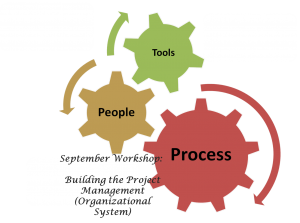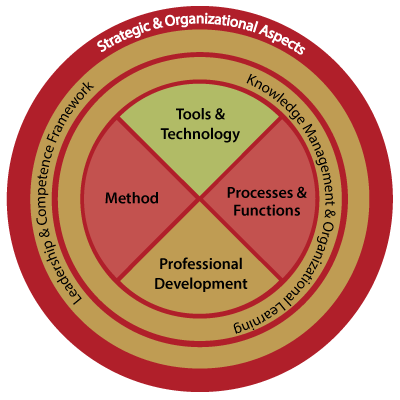Introduction
A few days ago, we published an article under the title “forget about building the PMO, build the project management (organizational) system” – let us abbreviate it as PMOS. In that article, we touched on our preferred approach, which is founded on three principles:
- Use a program management approach, in other words, treat the PMOS implementation initiative as a program rather than a project,
- Use an extended approach, meaning build the system over 1 to 3 years and not an intensive 3 to 6 months style,
- Follow the SUKAD Seven Elements of Project Management Maturity™ model (The 7Es™).
People, process, tools (technology)
Many would agree that, for effective project management, we need an emphasis on the tripod of  people, process, and tools (or technology). We present our views on this point through the following graphic. What is essential is to integrate the three aspects.
people, process, and tools (or technology). We present our views on this point through the following graphic. What is essential is to integrate the three aspects.
Now what usually happen in PMO implementation projects?
Some organizations start with a tool. If the organization is large, they might invest into an enterprise tool, or a scheduling tool, not realizing that the tool, in our humble opinion, is the least important of the three components; a tool will enhance efficiency not effectiveness.
Another mishap, is an organization hire an external consultant to build the process, with input but not proper involvement of the organization’s stakeholders (client organization). As we discussed in prior articles, another gap here is the consultant might implement the PMO process (as an office) and not the project management organizational system, which include methodology and other components.
We close this section with re-emphasizing the need for the three components (some call three engines of project management).
The Seven Elements of Project Management Maturity™
We discussed the 7Es™ in a prior post, and we will discuss each element in more details, in future posts. For now, all we want to discuss here is to link the people-process-tools concept to the SUKAD maturity model, via the next graphic.
As we can see from the image,
- Three of the elements are predominantly related to ‘people’; professional development, organizational learning, and competence framework,
- Two of the elements focus on ‘process’; method(ology) and processes and functions,
- One of the elements is specific to ‘tools and technology’,
- The outer element, strategic and organizational aspects, we did not force-fit into any of the three components since it is more of the guiding principle.
Although each of the elements are closely linked to one of the three components, ‘people-process-tools’, the relations extend into all elements and components.
Once again, in future articles we will expand on each of the seven elements.
 Why the extended (staged) approach?
Why the extended (staged) approach?
At the start of this article, we mentioned that we prefer an extended approach, why? Why do not we just focus on building the full system, put it into operations, and close the project?
From a consultant’s commercial perspective ((service provider), it is best to go into an organization, spend a few months to build a comprehensive solution, get the revenues and move on. However, we know that this approach, typically followed by many consultants, is not in the best interest of the client; for SUKAD it does not help us live up to our core values, including service distinction. The importance of the extended (staged) approach is that this approach allows individuals and organizations to, effectively, assimilate the new system. In our professional opinion, people can assimilate (concepts and application = learn by applying) new concepts if done in stages instead of a big-bang!
We do understand the need for quick wins and our approach will provide that. Even with the extended approach, we will be able to provide a system within a short time frame but this only possible at the higher level – a big picture perspective. Then we give the organization time to assimilate the new learning (assimilate = learn by applying), for a period of few weeks before we come back again to focus on one more of the elements or components of the system; for more in-depth coverage of those new components.
In term of cost, we believe this would be the cheaper option (or at least equal in cost) than working for 3 to 6 months to build a comprehensive system and leave. Actually, we think it would be cheaper if the clients’ personnel become encouraged to help build some of the components themselves. Further, the client financial commitment is staged, and the client could cancel future work if they do not see the added value.
Closing Remark
We know adaptation of the new system WILL have a higher chance of success and will be effective and sustainable; versus a quick implementation.



Trackbacks/Pingbacks